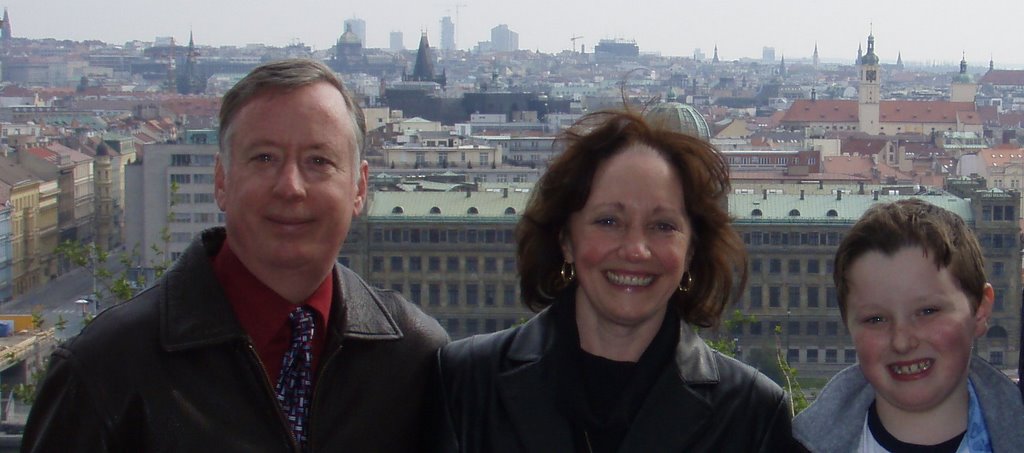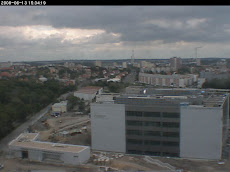I'll try to finish up with the Berlin trip today (no promises, though) by posting some pictures of other things we saw there.
This is the Victory Column about a mile west of the Brandenburg Gate through the Tiergarten. Wikipedia says "Surrounded by a street circle with heavy car traffic, pedestrians can reach the column through four tunnels, built in 1941 to plans by Albert Speer. Via a steep spiral staircase of 285 steps, the physically fit may climb up almost to the top of the pillar, to right underneath the statue, for a small fee and a spectacular view over the Tiergarten. Even many Berliners do not know that originally the column was erected with a height of merely 50.66 meters opposite the Reichstag building. In preparation of executing the monumental plans to redesign Berlin into Welthauptstadt Germania, in 1939, the Nazis relocated the pillar to its present location at the Großer Stern (Great Star), a large intersection on the visual city axis that leads from the former Berliner Stadtschloss (Berlin City Palace) through the Brandenburg Gate to the western parts of Berlin. At the same time, the pillar was augmented by another 7.5 meters, giving it its present height of 66.89 meters. The monument survived World War II without much damage. The relocation of the monument probably saved it from destruction, as its old site in front of the Reichstag was destroyed in the war."
The Brandenburg Gate is one of the most recognizable landmarks in Berlin. Again, Wikipedia - "it is the only remaining gate of a series through which one formerly entered Berlin. One block to its north lies the Reichstag. It constitutes the monumental termination of Unter den Linden, the renowned boulevard of Lime trees which led directly to the royal residence. It was commissioned by Friedrich Wilhelm II as a sign of peace and built by Carl Gotthard Langhans from 1788 to 1791.
While the main design of the Brandenburg Gate has remained the same since it was completed, the gate has played varying roles in Germany's history. First, Napoleon took the Quadriga to Paris in 1806 after conquering Berlin. When it returned to Berlin in 1814, the statue exchanged her olive wreath for the Iron Cross and became the goddess of victory.
When the Nazis rose to power, they used the gate to symbolize their power. The only structure left standing in the ruins of Pariser Platz in 1945, apart from the ruined Academy of Fine Arts, the gate was restored by the East Berlin and West Berlin governments. However, in 1961, the gate was closed when the Berlin Wall was built.
In 1963 U.S. President John F. Kennedy visited the Brandenburg Gate. The Soviets hung large banners across it so he could not see the East Berlin side. On June 12, 1987 U.S. President Ronald Reagan delivered a speech ("Tear down this wall") to the people of West Berlin at the Brandenburg Gate, yet it was also audible on the East Berlin side of the Wall."
Checkpoint Charlie - it's just the little wooden building with sandbags and flower memorials. Wikipedia points out "the checkpoint was curiously asymmetrical. During its 27-year active life, the infrastructure on the Eastern side was expanded to include not only the wall, watchtower and zig-zag barriers, but a multi-lane shed where cars and their occupants were checked. However the American authorities, perhaps not wanting to concede that the division of Germany might be anything other than a temporary aberration, never erected any permanent buildings, and made do with the iconic wooden shed."

Kaiser Wilhelm Memorial Church (in background) - [Wikipedia] "During World War II, the church was destroyed during a British RAF bombing raid in 1943. The only remainder of the old building is the ruin of the belfry, which are also referred to as "der Hohle Zahn" ("the hollow tooth").
After the war, from 1951 to 1961, a new church was built right next to the site of the old one according to the plans of Egon Eiermann. It features a cross made of nails from the old Coventry Cathedral, destroyed by German Luftwaffe bomb attacks in Britain, in what was called the Coventry Blitz. It was consecrated on May 25, 1962, the same day as the new Coventry Cathedral, which like the Gedächtniskirche, was built alongside the ruins of the old building, which were kept as reminders of the horrors of war."
Saturday, May 12, 2007
More sites of Berlin...
Subscribe to:
Post Comments (Atom)



No comments:
Post a Comment